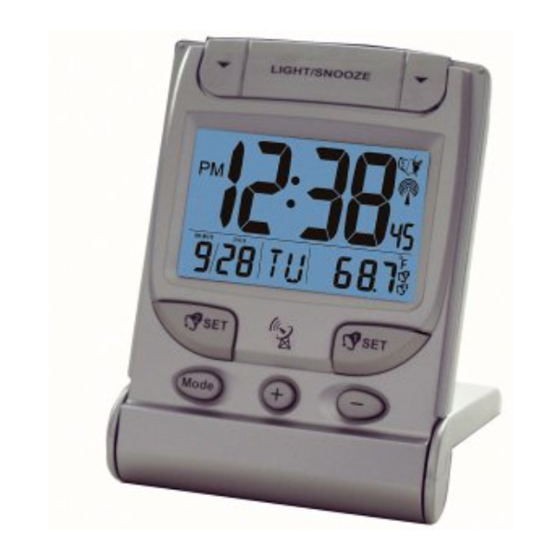Digiview RC61ELW Manual del usuario - Página 2
Navegue en línea o descargue pdf Manual del usuario para Reloj despertador Digiview RC61ELW. Digiview RC61ELW 8 páginas. Travel alarm clock with atomic time and temperature

FRONT VIEW
A. ATOMIC CLOCK WITH INDOOR
TEMPERATURE IN A TWO -
LINE LCD DISPLAY
F
LIGHT/SNOOZE
Time of Day with
Seconds, US Time
PM
Zone Map
Indoor Temperature
MONTH
DATE
1
2
Day of the week
2
1
SET
SET
SIZE AAA/UM4
C
D
E
B
Calendar
4
WWVB RADIO CONTROLLED TIME
The NIST (National Institute of Standards and
Technology) radio station (WWVB) is located in Ft.
Collins, Colorado. It transmits an exact time signal
continuously throughout the most of the continental
United States at 60 KHz frequency. The Travel Alarm
Clock can receive this WWVB signal through the
internal antenna from up to 2,000 miles away. Due to
the nature of the Earth's ionosphere, reception can be
limited during the daylight hours. The radio controlled
clock will search for an alternate station that receives
the atomic time signal from the NIST Atomic clock in
Boulder, Colorado.
The WWVB tower icon on the unit's display will flash
indicating a radio signal reception from the WWVB
station. If the tower icon is not fully lit, or if the time
and date are not set automatically, please consider the
following:
* During night-time hours, atmospheric disturbances
are typically less severe and radio signal reception
may improve. A single daily reception is sufficient
enough to keep the clock accuracy within 1 second.
* Make sure the unit is positioned at 8 feet (2 meters)
distance from any interference source such as a TV,
computer monitor, microwave, etc.
* Within concrete wall rooms such as basements or
office buildings, the received signal may be weakened.
Always place the Travel Alarm Clock near the
window for better reception.
6
B. SET1 & SET2 BUTTONS
* Select and set Alarm One and Alarm Two
* Recall current alarms status
C. MODE BUTTON
* Allows toggle between display modes (Alarm1,
Alarm2 and Temperature)
* Activates manual programming mode
* Activates or deactivates the atomic time receiver
D. UP ( + ) BUTTON
* Increases all function parameters
* Selects 12 or 24 hour time display format
* Activates US Time Zone selection mode
E. DOWN ( – ) BUTTON
* Decreases all function parameters
* Sets the language for the day of the week
F. SNOOZE/LIGHT BUTTON
* Activates snooze function and LCD backlight
REAR VIEW
G. BATTERY COMPARTMENT
* Accommodates one (1) UM-4 or AAA 1.5V alkaline
batteries.
5
GETTING STARTED
BATTERY INSTALLATION
* Open the battery compartment door.
* Install one (1) batteries AAA (UM-4) size 1.5V matching
the polarity as shown in the battery compartment.
* Replace the battery compartment door.
ATOMIC CLOCK
Immediately after batteries are installed, the atomic time
signal receiver will start to search for the time signal. It
usually takes between 5-8 minutes.
Once the atomic time signal is received, the date and time
will be set automatically, and the [
] icon will appear.
If the time signal has not been received in 8 minutes, press
MODE button to set the time and date manually.
After the clock is set manually, place it by the window for
the better reception. The atomic clock receiver is
programmed that it will continue to search for the atomic
time signal daily for every hour between 1:00 am and
4:30 am. Once the time signal has been successfully
received, the time and date will be updated automatically.
CALENDAR AND CLOCK DISPLAY MODES
Precise time is displayed in hour-
minutes-seconds format on the top
PM
ine of the Atomic Alarm Clock.
The date is displayed in month-date
MONTH
DATE
format on the bottom line next to the
day of the week.
Both Alarms share the space with
Indoor Temperature and can be
viewed by pressing of the MODE
button.
7
1
2
